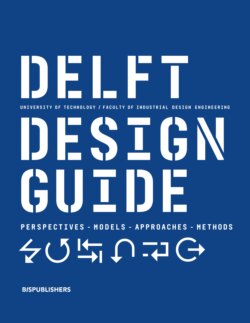Читать книгу Delft Design Guide -Revised edition - Annemiek van Boeijen - Страница 24
На сайте Литреса книга снята с продажи.
Оглавление20. Design for Behavioural Change
Design for Behavioural Change
What & Why? Designers are increasingly asked to create interventions via products, services, or combinations that support the realisation of a behavioural change.
In Design for Behavioural Change, models are used from psychology and social science that aim to describe the psychological process of behaviour. From psychology it is known that when people change their behaviour, they often go through three stages: 1. Awareness of the new behaviour including contemplation and the intention to try the new behaviour, 2. Action preparing and starting the new behaviour, and 3. Maintenance maintaining and habituating the new behaviour. You should be aware of these stages of change with respect to your intended users and then tailor your design accordingly. A change in behaviour is often the main indicator of success, and it can be measured either during the interaction with experience-oriented measurements; directly after the interaction with intention-oriented measurements; or after a longer period following the interaction with behaviour- and attitude-oriented measurements. Design for Behavioural Change is not limited to a behavioural aim in a strict sense, which is understood as an execution of bodily action. It can also target raising awareness, influencing a social change, or facilitate a cognitive change.
For example, when you design a smart pill box that selects the right daily amount of medication and sends persuasive reminders to patients when they did not take it, the behavioural goal of the designed device is clearly communicated to the patient. In this case, ethical concerns might involve questions regarding patient dependency and trustworthiness of the system. In nudging practices, the behavioural design goal is often not clearly communicated to the user. For instance, a candy shop may try to persuade people to buy their candies by placing them at a grabbing level near the counter. In these cases, people are influenced by product placement without knowing it, and this might even conflict with the person’s personal behavioural intentions, such as to eat healthy.
-------------------------------------------------------------------------------------------------------------------
Mindset: DfBC raises ethical questions. The importance of an ethical discussion depends on the product or service and the situation.
-------------------------------------------------------------------------------------------------------------------
References & Further Reading: Prochaska, J.O., & DiClemente, C.C., 1983. Stages and processes of self-change of smoking: toward an integrative model of change. Journal of consulting and clinical psychology , 51(3), 390. / van der Kooij, K., Hoogendoorn, E., Spijkerman, R. & Visch, V., 2015. Validation of games for behavioral change: connecting the playful and serious. International Journal of Serious Games , 2(3), 63-75. / Cash, P.J., Hartlev, C.G., & Durazo, C.B., 2017. Behavioural design: A process for integrating behaviour change and design. Design Studies , 48, 96-128./ Darnton, A., 2008. An overview of behaviour change models and their uses. GSR Behaviour Change Knowledge Review (p. 81). Retrieved from https://research.fit.edu/media/site-specific/researchfitedu/coast-climate-adaptation-library/climate-communications/messaging-climate-change/ Darnton.-2008.-Behaviour-Change-Models--Uses.pdf
Tips & Concerns
Take ethical issues into consideration. See the section ‘Mindset’.
--------
For a good understanding of individual behaviour, you need to understand the sociocultural context people live in.
--------
Work together with multiple stakeholders and disciplines, such as those in psychology and anthropology, implementation partners, and intended users.
--------
Focus not only on quick and short-term motivations for behavioural change but also include long-term motivational strategies.
--------
Anticipate the possible unexpected outcomes as well as the difficult and sensitive situations.
--------
Design processes for behavioural Change are typically iterative and involve co-creation sessions and observations.
--------------------------------------
Limitations
Influence of designers through design is limited. In practice there are many, sometimes unforeseen factors on a personal and societal level that will influence a person’s behaviour and the effect of your intervention.
Design for Behavioural Change (DfBC) concerns designing products and services with the aim to change people’s behaviour. A behavioural change project is multi-disciplinary in nature. Design interventions often support people to create awareness and help them either realise an intended behaviour or maintain a preferred behaviour.
perspectives
---------------------------------------------------------------------------------------------------------------------------------------------------------------
23
How? Various approaches and methods are developed to support Design for Behavioural Change. Persuasive Game Design in this guide offers a design recipe for a behavioural change involving
motivating game elements. The card set Cards-for-Change can be used for discovering and selecting existing behavioural change techniques that can be used in your design.
